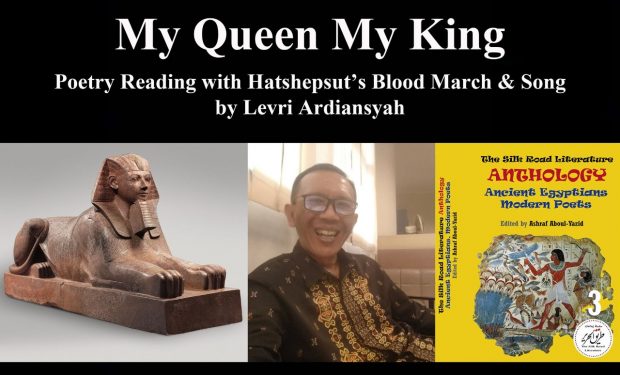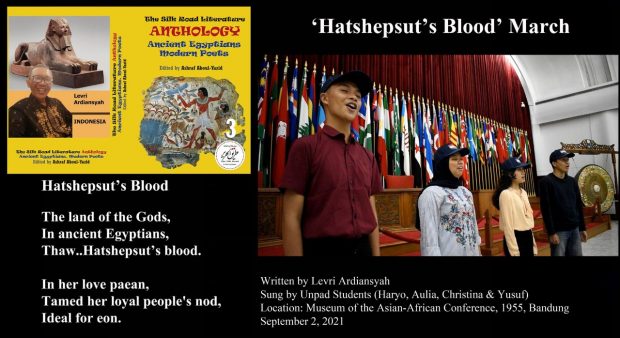
Indonesian song to celebrate ancient Egyptian Queen Hatshepsut

By Asian editor,
Banten, Java, Indonesia: There is something unique in book titled ‘The Silk Road Literature Anthology, Ancient Egyptians, Modern Poets’ edited by Ashraf Aboul Yazid.
A marching song titled ‘Hatshepsut’s Blood’ created by Levri Ardiansyah has beautified the poetic words in this book.
In a chat with Ashraf Aboul-Yazid, Levri said that he took the cool opportunity by trying something different for ancient Egyptian anthology.
He presents a song based on his poetry titled ‘Hatshepsut’s Blood’ written in this book. He wrote 4 poetries in English and Indonesian i.e. (1) Hatshepsut’s Blood; (2) Darah Hatshepsut; (3) My Queen My King and (4) Ratuku Rajaku.
Levri Ardiansyah is a lecturer, researcher, bilingual poet (Indonesian and English), a generalist and an author. He has authored numerous books of philosophy, poetry and administration, among them are ‘Induction of Science of Administration’ (2016), ‘Earth and the Laws of Association’ (2017), ‘Ouroboros, Filosofi dan Ilmu’ (2019), ‘Puisi Ouroboros (2019)’, and Ouroboric Poetry’ (2020).
His poetry titled ‘One Asia Sings’ has been published in ‘The Silk Road Literature Series, Anthology, Asia Sings’ book edited by Ashraf Aboul-Yazid (2021). And poetry titled ‘My Own Healing Presence’ also ‘Do I Love Death’ have been published in ‘The Silk Road Literature Series, Anthology, Mediterranean Waves’ book edited by Ashraf Aboul-Yazid (2021).
Levri made ‘My Queen My King’ video as an accompanied poetry reading video with Hatshepsut’s Blood march & song, based on Poetry titled ‘My Queen My King’ has been read by Dr. Ir. Andi Agus Nur, MT. lecturer at Geological Engeneering, Universitas Padjadjaran, Indonesia, and poetry titled ‘Hatshepsut’s Blood’ sung as a marching song, by Universitas Padjadjaran Singing Students (Haryo Probo Kusumo, Aulia Aziza Putri, Christina Nathalia Saragi and Yusuf Aulia Rahman).
In this ancient Egyptian, he has a vision of a moment so unique that led him increasingly interested in history of Hatshepsut, especially he once wrote this history and its philosophy on his book titled ‘Ouroboros, Philosophy and Science’ (2018). Hatshepsut was the first woman to exercise long-term rule over Egypt as a king.
Hatshepsut achieved her power without bloodshed or social trauma. Cooney, Kara (2004) wrote in ‘The Woman Who Would be King Hatshepsut’s Rise to Power in Ancient Egypt. First Edition’ (New York: Crown Publishers: ‘Though Hatshepsut’s rise to power was clean and creative, it required every weapon in her arsenal —invoking her bloodline, education, political acumen, along with a deep (and sometimes radical) understanding of religious power’.

Another interesting thing in this book is the series of ‘The Silk Road Literature’ organized by Ashraf Aboul-Yazid which is related to UNESCO Silk Roads Programme.
In Levri’s view, the Silk Road is a network of ancient trade routes as a center of cultural interaction on the Asian African continent.
The trade and cultural contact between ancient Asian-African led to Indonesia as World Maritime Axis having important roles in politics, religion, culture and society. The continuity and autonomy of Southeast Asian history especially The Hindu states of Indochina at Indonesia (Les Etats hindouisés d’Indochine at d’Indonésie) has been written Professor G. Coedes (1964, 3d. ed.) in a book titled “Les Etats hindouisés d’Indochine at d’Indonésie”, Paris: Editions E. De Boccard.
This ‘Silk Roads’ theme has prompted Levri to shoot a ‘My Queen My King’ video taking place in the Museum of the Asian African Conference, also known as Bandung Conference.
The conference promotes Asian-African economic and cultural cooperation and opposes colonialism or neocolonialism by any nation. An important step towards the eventual creation of the Non-Aligned Movement.
Video links:
“Hatshepsut’s Blood March & Song”
“My Queen My King”


